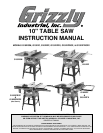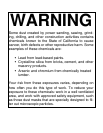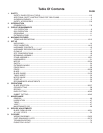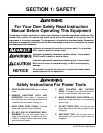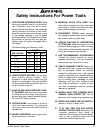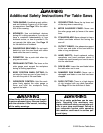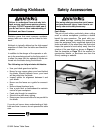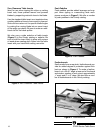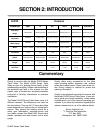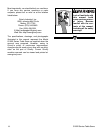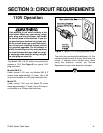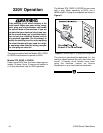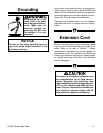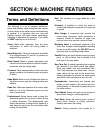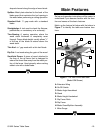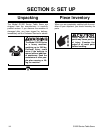
G1022 Series Table Saws -5-
Push Sticks
The use of push sticks, particularly when cutting
small or narrow workpieces, provides a double
benefit for saw operators. The push stick pro-
vides added leverage, enabling the operator to
keep the workpiece firmly supported against the
fence and table. At the same time, the push stick
keeps the operator’s hand safely away from the
rotation of the saw blade as shown in Figure 1.
See the template on Page 76 of the manual for
construction details, or purchase one from the
Grizzly catalog or website.
Safety Accessories
Not using safety accessories could cause
serious personal injury. Learn how to cor-
rectly use each safety accessory.
Figure 1. Push Stick.
Push Stick
Statistics prove that most common accidents
among table saw users can be linked to kick-
back.
Kickback is typically defined as the high-speed
expulsion of stock from the table saw toward its
operator.
In addition to the danger of the operator or oth-
ers in the area being struck by the flying stock, it
is often the case that the operator’s hands are
forced into the blade during the kickback.
The following can help minimize kickbacks:
• Use your blade guard and splitter.
• Never for any reason place your hand behind
the blade. Should kickback occur, your hand
will be pulled into the blade.
• Inspect splitter for alignment between it and
your blade.
• Never use the fence as a guide for crosscut-
ting.
• Never attempt freehand cuts.
• Use a push stick or featherboard to maintain
control of your workpiece.
• Feed cuts through to completion.
• Stand to the side when ripping.
• Ensure your fence and miter slot are parallel to
the blade.
If you do not have a clear understanding of kick-
back and how it occurs, do not operate this table
saw.
Failure to understand how and why kick-
back occurs could cause serious person-
al injury. DO NOT operate this table saw if
you do not have a clear understanding of
kickback, and how it occurs.
Avoiding Kickback



